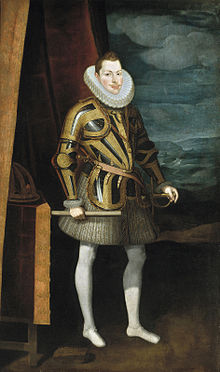Juan Pantoja de la Cruz
| Juan Pantoja de La Cruz | |
|---|---|

Portrait of Philip III of Spain by Juan Pantoja de la Cruz
|
|
| Born |
Juan Pantoja de La Cruz 1553 Valladolid |
| Died | 26 October 1608 (aged 54–55) Madrid, Spain |
| Nationality | Spanish |
| Known for | Painting |
Juan Pantoja de La Cruz (1553 – 26 October 1608) was a Spanish painter, one of the best representatives of the Spanish school of court painters. He worked for Philip II and Philip III. The Museo del Prado contains examples of his severe portraiture style.
Juan Pantoja de La Cruz was born in 1553 in Valladolid. Very little is known of his formative years as a painter. He was a pupil of the court painter Alonso Sánchez Coello in Madrid and he must have assisted his master in complying with his duties as painter of the Spanish King, Philip II. Pantoja probably continued to work in his master studio after completing his training. He married in 1585 beginning to paint for the court around that time. After Sanchez Coello's death in 1588, Pantoja took over his master workshop and became court painter to Philip II of Spain.
Pantoja kept working for the court and the nobility, painting portraits of Prince Philip, the future Philip III, in 1592 and 1594. Among his most well known works is the portrait of Philip II wearing a cape and hat all in black, painted around 1594 for the Escorial. This portrait is one of the best representations of the idea of Spanish majesty, based on the remoteness of the monarch. On Philip II's death in 1598, Philip III confirmed Pantoja's status as court painter. When the court settled in Valladolid in 1601, Pantoja moved to the new capital, remaining in this city, several years.
Juan Pantoja de la Cruz painted a great number of state portraits with the combined forces of his studio, his attendants, apprentices, and collaborators. He was primarily a portrait painter to the royal family, (whom he accompanied on journeys to Valladolid, Burgos, Lerma and the Escorial), and to the higher aristocracy. Pantoja also painted religious works primarily commissioned by the Spanish Queen, Margarita of Austria, wife of Philip III. Pantoja's paintings of religious themes also contain many portraits as auxiliary figures as in The Birth of the Blessed Virgin (1603) in which he included the mother of the Queen. He painted still lifes as well, but, like his ceiling frescoes, these have not survived. Pantoja returned with the court to Madrid and he died there on 26 October 1608.
...
Wikipedia
